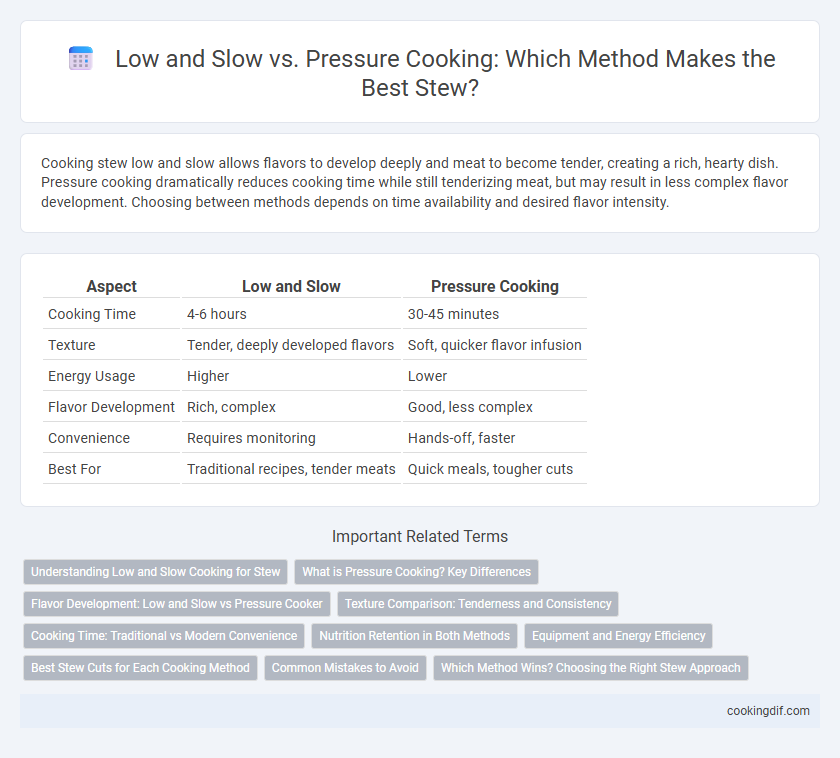Cooking stew low and slow allows flavors to develop deeply and meat to become tender, creating a rich, hearty dish. Pressure cooking dramatically reduces cooking time while still tenderizing meat, but may result in less complex flavor development. Choosing between methods depends on time availability and desired flavor intensity.
Table of Comparison
| Aspect | Low and Slow | Pressure Cooking |
|---|---|---|
| Cooking Time | 4-6 hours | 30-45 minutes |
| Texture | Tender, deeply developed flavors | Soft, quicker flavor infusion |
| Energy Usage | Higher | Lower |
| Flavor Development | Rich, complex | Good, less complex |
| Convenience | Requires monitoring | Hands-off, faster |
| Best For | Traditional recipes, tender meats | Quick meals, tougher cuts |
Understanding Low and Slow Cooking for Stew
Low and slow cooking for stew involves simmering ingredients at a low temperature over an extended period, allowing connective tissues in meat to break down and flavors to meld deeply. This method enhances tenderness and develops complex, rich flavors that are often unmatched by faster techniques. Maintaining consistent low heat ensures moisture retention and a velvety texture, making it ideal for traditional, hearty stews.
What is Pressure Cooking? Key Differences
Pressure cooking is a cooking method that uses steam pressure to cook food quickly by raising the boiling point of water, significantly reducing cooking time compared to traditional low and slow methods. Unlike slow cooking stews for several hours at low temperatures to develop rich flavors and tenderize meat gradually, pressure cooking achieves similar tenderness in a fraction of the time, typically under an hour. The key difference lies in the cooking environment: sealed and pressurized for faster heat penetration versus open, low-temperature simmering for extended periods, impacting flavor depth and texture.
Flavor Development: Low and Slow vs Pressure Cooker
Low and slow cooking allows flavors to meld deeply through gradual collagen breakdown and Maillard reactions, resulting in richer, more complex stews. Pressure cooking rapidly tenderizes meat but may sacrifice some depth of flavor due to shortened cooking times and reduced evaporation. For maximum flavor development, slow simmering is preferred despite the convenience of pressure cooking.
Texture Comparison: Tenderness and Consistency
Low and slow cooking breaks down collagen gradually in stew meat, resulting in tender, melt-in-the-mouth texture and rich, thick consistency. Pressure cooking accelerates collagen breakdown through high heat and steam pressure, producing tender meat faster but with a slightly less developed, thinner sauce. The choice depends on whether optimal tenderness and sauce depth are prioritized over cooking time efficiency.
Cooking Time: Traditional vs Modern Convenience
Traditional low and slow stew cooking typically requires several hours, allowing flavors to develop deeply and meat to become tender through gentle heat. Pressure cooking significantly reduces cooking time to under an hour by using high pressure and temperature to break down tough fibers efficiently. This modern convenience balances speed with flavor infusion, offering a practical alternative without compromising texture or taste.
Nutrition Retention in Both Methods
Low and slow cooking preserves more nutrients like vitamins B and C by gently breaking down connective tissues without high heat degradation in stew. Pressure cooking reduces cooking time significantly but may cause some loss of heat-sensitive nutrients due to higher temperatures and steam pressure. Both methods retain minerals effectively, but low and slow cooking offers superior retention of delicate vitamins important for nutritional value.
Equipment and Energy Efficiency
Low and slow cooking for stew relies on traditional stovetop or slow cooker equipment, which uses steady, moderate heat over several hours, consuming more energy but preserving complex flavors and tender textures. Pressure cooking employs a sealed pressure cooker that significantly reduces cooking time and energy consumption by rapidly increasing pressure and temperature, making it a more energy-efficient choice. While pressure cookers deliver faster results with less fuel, low and slow methods benefit from simpler equipment and enhanced flavor development through prolonged heat exposure.
Best Stew Cuts for Each Cooking Method
Tough, connective tissue-rich cuts like chuck roast and brisket are ideal for low and slow cooking, as the prolonged heat breaks down collagen, resulting in tender, flavorful stew. In contrast, pressure cooking suits moderately tender cuts such as sirloin or shoulder, which cook quickly and remain juicy without becoming mushy. Selecting the right cut based on the cooking method ensures optimal texture and rich, savory depth in your stew.
Common Mistakes to Avoid
Overcooking stew using the low and slow method can result in mushy vegetables and dry meat, while underestimating cooking time in pressure cooking may leave tough, undercooked chunks. Common mistakes include not adjusting liquid levels appropriately; low and slow requires more liquid loss due to evaporation, whereas pressure cooking needs less to prevent overly watery stew. Using improper cuts of meat too lean for the chosen method often leads to a lack of tenderness and flavor, so selecting well-marbled beef chuck for low and slow or stew beef cubes for pressure cooking is essential.
Which Method Wins? Choosing the Right Stew Approach
Low and slow cooking enhances stew flavors by breaking down tough meat fibers and melding spices over a prolonged period, resulting in rich, tender textures. Pressure cooking significantly reduces cooking time while efficiently tenderizing ingredients, making it ideal for busy schedules without sacrificing depth of flavor. Choosing the right method depends on balancing time constraints with desired texture and flavor intensity, with low and slow preferred for traditional richness and pressure cooking favored for convenience.
Low and slow vs pressure cooking for stew method Infographic

 cookingdif.com
cookingdif.com